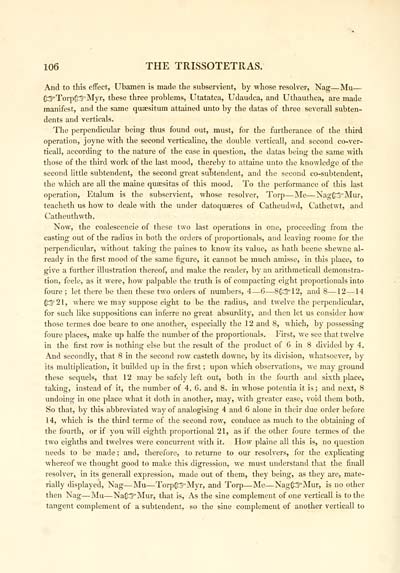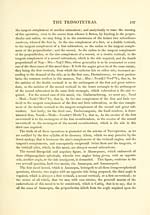Maitland Club > Works of Sir Thomas Urquhart
(148) Page 106
Download files
Complete book:
Individual page:
Thumbnail gallery: Grid view | List view

106 THE TRISSOTETRAS.
And to this effect, Ubamen is made the subservient, by whose resolver, Nag — Mu —
C^TorpC^Myr, these three problems, Utatatca, Udaudca, and Uthauthca, are made
manifest, and the same quaesitum attained unto by the datas of three several! subten-
dents and verticals.
The perpendicular being thus found out, must, for the furtherance of the third
operation, joyne with the second verticaline, the double verticall, and second co-ver-
ticall, according to the nature of the case in question, the datas being the same with
those of the third work of the last mood, thereby to attaine unto the knowledge of the
second little subtendent, the second great subtendent, and the second co-subtendent,
the which are all the maine quaesitas of this mood. To the performance of this last
operation, Etalum is the subservient, whose resolver, Torp — Me — NagG3°Mur,
teacheth us how to deale with the under datoquaeres of Catheudwd, Cathetwt, and
Catheuthwth.
Now, the coalescencie of these two last operations in one, proceeding from the
casting out of the radius in both the orders of proportionals, and leaving roome for the
perpendicular, without taking the paines to know its value, as hath beene shewne al-
ready in the first mood of the same figure, it cannot be much amisse, in this place, to
give a further illustration thereof, and make the reader, by an arithmeticall demonstra-
tion, feele, as it were, how palpable the truth is of compacting eight proportionals into
foure ; let there be then these two orders of numbers, 4 — 6 — 8i^l2, and 8 — 12 — 14
03=21, where we may suppose eight to be the radius, and twelve the perpendicular,
for such like suppositions can inferre no great absurdity, and then let us consider how
those termes doe beare to one another, especially the 12 and 8, which, by possessing
foure places, make up halfe the number of the proportionals. First, we see that twelve
in the first row is nothing else but the result of the product of 6 in 8 divided by 4.
And secondly, that 8 in the second row casteth downe, by its division, whatsoever, by
its multiplication, it builded up in the first ; upon which observations, we may ground
these sequels, that 12 may be safely left out, both in the fourth and sixth place,
taking, instead of it, the number of 4. 6. and 8. in whose potentia it is; and next, 8
undoing in one place what it doth in another, may, with greater ease, void them both.
So that, by this abbreviated way of analogising 4 and 6 alone in their due order before
14, which is the third terme of the second row, conduce as much to the obtaining of
the fourth, or if you will eighth proportional 21, as if the other foure termes of the
two eighths and twelves were concurrent with it. How plaine all this is, no question
needs to be made ; and, therefore, to returne to our resolvers, for the explicating
whereof we thought good to make this digression, we must understand that the finall
resolver, in its generall expression, made out of them, they being, as they are, mate-
rially displayed, Nag — Mu — Torpftr'Myr, and Torp — Me — NagC3=Mur, is no other
then Nag — Mu — Na&3*Mur, that is, As the sine complement of one verticall is to the
tangent complement of a subtendent, so the sine complement of another verticall to
And to this effect, Ubamen is made the subservient, by whose resolver, Nag — Mu —
C^TorpC^Myr, these three problems, Utatatca, Udaudca, and Uthauthca, are made
manifest, and the same quaesitum attained unto by the datas of three several! subten-
dents and verticals.
The perpendicular being thus found out, must, for the furtherance of the third
operation, joyne with the second verticaline, the double verticall, and second co-ver-
ticall, according to the nature of the case in question, the datas being the same with
those of the third work of the last mood, thereby to attaine unto the knowledge of the
second little subtendent, the second great subtendent, and the second co-subtendent,
the which are all the maine quaesitas of this mood. To the performance of this last
operation, Etalum is the subservient, whose resolver, Torp — Me — NagG3°Mur,
teacheth us how to deale with the under datoquaeres of Catheudwd, Cathetwt, and
Catheuthwth.
Now, the coalescencie of these two last operations in one, proceeding from the
casting out of the radius in both the orders of proportionals, and leaving roome for the
perpendicular, without taking the paines to know its value, as hath beene shewne al-
ready in the first mood of the same figure, it cannot be much amisse, in this place, to
give a further illustration thereof, and make the reader, by an arithmeticall demonstra-
tion, feele, as it were, how palpable the truth is of compacting eight proportionals into
foure ; let there be then these two orders of numbers, 4 — 6 — 8i^l2, and 8 — 12 — 14
03=21, where we may suppose eight to be the radius, and twelve the perpendicular,
for such like suppositions can inferre no great absurdity, and then let us consider how
those termes doe beare to one another, especially the 12 and 8, which, by possessing
foure places, make up halfe the number of the proportionals. First, we see that twelve
in the first row is nothing else but the result of the product of 6 in 8 divided by 4.
And secondly, that 8 in the second row casteth downe, by its division, whatsoever, by
its multiplication, it builded up in the first ; upon which observations, we may ground
these sequels, that 12 may be safely left out, both in the fourth and sixth place,
taking, instead of it, the number of 4. 6. and 8. in whose potentia it is; and next, 8
undoing in one place what it doth in another, may, with greater ease, void them both.
So that, by this abbreviated way of analogising 4 and 6 alone in their due order before
14, which is the third terme of the second row, conduce as much to the obtaining of
the fourth, or if you will eighth proportional 21, as if the other foure termes of the
two eighths and twelves were concurrent with it. How plaine all this is, no question
needs to be made ; and, therefore, to returne to our resolvers, for the explicating
whereof we thought good to make this digression, we must understand that the finall
resolver, in its generall expression, made out of them, they being, as they are, mate-
rially displayed, Nag — Mu — Torpftr'Myr, and Torp — Me — NagC3=Mur, is no other
then Nag — Mu — Na&3*Mur, that is, As the sine complement of one verticall is to the
tangent complement of a subtendent, so the sine complement of another verticall to
Set display mode to: Large image | Transcription
Images and transcriptions on this page, including medium image downloads, may be used under the Creative Commons Attribution 4.0 International Licence unless otherwise stated. ![]()
| Publications by Scottish clubs > Maitland Club > Works of Sir Thomas Urquhart > (148) Page 106 |
|---|
| Permanent URL | https://digital.nls.uk/82500897 |
|---|

